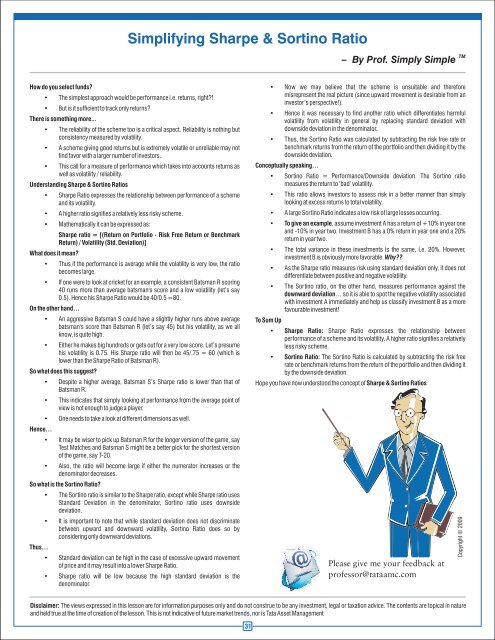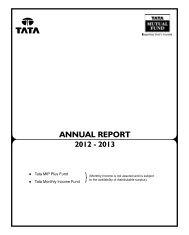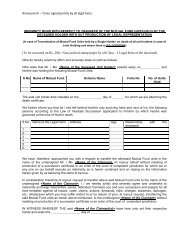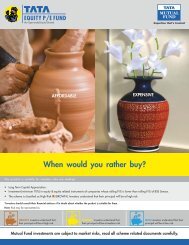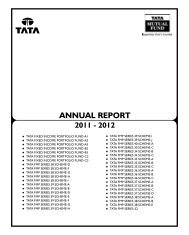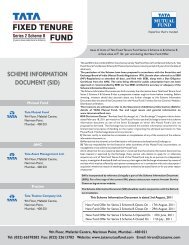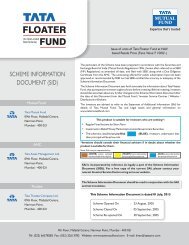Fact Sheet April - 2013.cdr - Tata Mutual Fund
Fact Sheet April - 2013.cdr - Tata Mutual Fund
Fact Sheet April - 2013.cdr - Tata Mutual Fund
You also want an ePaper? Increase the reach of your titles
YUMPU automatically turns print PDFs into web optimized ePapers that Google loves.
Simplifying Sharpe & Sortino Ratio– By Prof. Simply SimpleTMHow do you select funds?• The simplest approach would be performance i.e. returns, right?!• But is it sufficient to track only returns?There is something more...• The reliability of the scheme too is a critical aspect. Reliability is nothing butconsistency measured by volatility.• A scheme giving good returns but is extremely volatile or unreliable may notfind favor with a larger number of investors.• This call for a measure of performance which takes into accounts returns aswell as volatility / reliability.Understanding Sharpe & Sortino Ratios• Sharpe Ratio expresses the relationship between performance of a schemeand its volatility.• A higher ratio signifies a relatively less risky scheme.• Mathematically it can be expressed as:What does it mean?Sharpe ratio = [(Return on Portfolio - Risk Free Return or BenchmarkReturn) / Volatility (Std. Deviation)]• Thus if the performance is average while the volatility is very low, the ratiobecomes large.• If one were to look at cricket for an example, a consistent Batsman R scoring40 runs more than average batsman's score and a low volatility (let’s say0.5). Hence his Sharpe Ratio would be 40/0.5 =80.On the other hand…• An aggressive Batsman S could have a slightly higher runs above averagebatsman's score than Batsman R (let’s say 45) but his volatility, as we allknow, is quite high.• Either he makes big hundreds or gets out for a very low score. Let’s presumehis volatility is 0.75. His Sharpe ratio will then be 45/.75 = 60 (which islower than the Sharpe Ratio of Batsman R).So what does this suggest?Hence…• Despite a higher average, Batsman S’s Sharpe ratio is lower than that ofBatsman R.• This indicates that simply looking at performance from the average point ofview is not enough to judge a player.• One needs to take a look at different dimensions as well.• It may be wiser to pick up Batsman R for the longer version of the game, sayTest Matches and Batsman S might be a better pick for the shortest versionof the game, say T-20.• Also, the ratio will become large if either the numerator increases or thedenominator decreases.So what is the Sortino Ratio?Thus…• The Sortino ratio is similar to the Sharpe ratio, except while Sharpe ratio usesStandard Deviation in the denominator, Sortino ratio uses downsidedeviation.• It is important to note that while standard deviation does not discriminatebetween upward and downward volatility, Sortino Ratio does so byconsidering only downward deviations.• Standard deviation can be high in the case of excessive upward movementof price and it may result into a lower Sharpe Ratio.• Sharpe ratio will be low because the high standard deviation is thedenominator.• Now we may believe that the scheme is unsuitable and thereforemisrepresent the real picture (since upward movement is desirable from aninvestor’s perspective!).• Hence it was necessary to find another ratio which differentiates harmfulvolatility from volatility in general by replacing standard deviation withdownside deviation in the denominator.• Thus, the Sortino Ratio was calculated by subtracting the risk free rate orbenchmark returns from the return of the portfolio and then dividing it by thedownside deviation.Conceptually speaking…To Sum Up• Sortino Ratio = Performance/Downside deviation. The Sortino ratiomeasures the return to ‘bad’ volatility.• This ratio allows investors to assess risk in a better manner than simplylooking at excess returns to total volatility.• A large Sortino Ratio indicates a low risk of large losses occurring.• To give an example, assume investment A has a return of +10% in year oneand -10% in year two. Investment B has a 0% return in year one and a 20%return in year two.• The total variance in these investments is the same, i.e. 20%. However,investment B is obviously more favorable. Why??• As the Sharpe ratio measures risk using standard deviation only, it does notdifferentiate between positive and negative volatility.• The Sortino ratio, on the other hand, measures performance against thedownward deviation… so it is able to spot the negative volatility associatedwith investment A immediately and help us classify investment B as a morefavourable investment!• Sharpe Ratio: Sharpe Ratio expresses the relationship betweenperformance of a scheme and its volatility. A higher ratio signifies a relativelyless risky scheme.• Sortino Ratio: The Sortino Ratio is calculated by subtracting the risk freerate or benchmark returns from the return of the portfolio and then dividing itby the downside deviation.Hope you have now understood the concept of Sharpe & Sortino RatiosPlease give me your feedback atprofessor@tataamc.comCopyright © 2009Disclaimer: The views expressed in this lesson are for information purposes only and do not construe to be any investment, legal or taxation advice. The contents are topical in natureand held true at the time of creation of the lesson. This is not indicative of future market trends, nor is <strong>Tata</strong> Asset Management31


